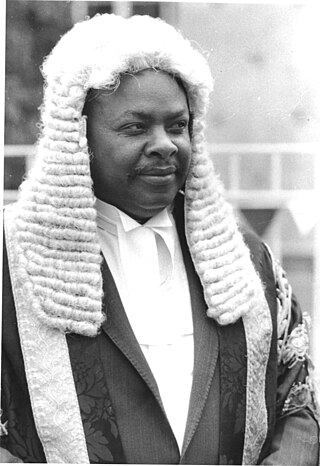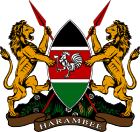
The politics of Kenya take place in a framework of a presidential representative democratic republic, whereby the president is both head of state and head of government, and of a multi-party system in accordance with a new constitution passed in 2010.

The Kenya African National Union (KANU) is a Kenyan political party that ruled for nearly 40 years after Kenya's independence from British colonial rule in 1963 until its electoral loss in 2002. It was known as Kenya African Union (KAU) from 1944 but due to pressure from the colonial government, KAU changed its name to Kenya African Study Union (KASU) mainly because all political parties were banned in 1939 following the start of the Second World War. In 1946 KASU rebranded itself into KAU following the resignation of Harry Thuku as president due to internal differences between the moderates who wanted peaceful negotiations and the militants who wanted to use force, the latter forming the Aanake a forty, which later became the Mau Mau. His post was then occupied by James Gichuru, who stepped down for Jomo Kenyatta in 1947 as president of KAU. The KAU was banned by the colonial government from 1952 to 1960. It was re-established by James Gichuru in 1960 and renamed KANU on 14 May 1960 after a merger with Tom Mboya's Kenya Independence Movement.

Emilio Mwai Kibaki was a Kenyan politician who served as the third President of Kenya from December 2002 until April 2013.

Uhuru Muigai Kenyatta is a Kenyan politician who served as the fourth president of Kenya from 2013 to 2022.

Elections in Kenya take place within the framework of a multi-party democracy and a presidential system. The President, Senate and National Assembly are directly elected by voters, with elections organised by the Independent Electoral and Boundaries Commission (IEBC).
The Forum for the Restoration of Democracy–Asili (FORD–Asili) is a political party in Kenya. Asili means 'original' in Swahili. FORD-Asili has its origins in the original Forum for the Restoration of Democracy. In August 1992, the original FORD split into two factions. The Odinga-Wamalwa faction remained in the original Nairobi party headquarters at Agip House on Haile Selassie Avenue whilst the Matiba-Shikuku faction moved to Muthithi House on Muthithi Road in Westlands. Thus for a period prior to registration as independent parties, the two factions were known as FORD-Agip and FORD-Muthithi. FORD-Agip was registered as FORD-Kenya whilst FORD-Muthithi was registered as FORD-Asili. Both parties went on to field competitive presidential candidates in the December 1992 general elections. FORD-Asili's candidate Kenneth Matiba polled second to KANU's Daniel Toroitich arap Moi in 1992 and won 31 parliamentary seats, dominating Murang'a District in Central Province and garnering a credible portion of the votes in Eastern and Western Provinces. By 1997, Kenneth Matiba and Martin Shikuku disagreed on a number of matters resulting in Matiba's departure from the party, his destruction of his voter's card and refusal to stand in the 1997 Presidential Elections. Martin Shikuku therefore won the party's presidential nomination and went on to win only 0.6% of the Presidential Vote, with the party winning 1 National Assembly seat. In the 2002 election, Ford-Asili won 2 out of 212 elected seats and did not field a presidential candidate, choosing to support the successful NARC alliance candidate Mwai Kibaki. In 2007, Ford-Asili supported Mwai Kibaki again as presidential candidate, this time under the Party of National Unity banner and won a single parliamentary seat in its own right. In the same election, the party's original presidential candidate Kenneth Matiba re-registered as a voter and stood under the Saba Saba-Asili banner. Matiba came in 7th with only 0.081% of the vote.
Kenneth Stanley Njindo Matiba was a Kenyan politician and an activist for democracy. He came in at second place in the 1992 presidential election. In November 2007, he announced that he would stand as a presidential candidate in the December 2007 election. Matiba placed seventh, with 8,046 votes.
Henry Pius Masinde Muliro was a Kenyan politician from the Bukusu sub-tribe of the larger Abaluhya people of western Kenya. He was one of the central figures in the shaping of the political landscape in Kenya. A renowned anti-colonial activist, he campaigned for the restoration of multi-party democracy in Kenya in his later years.

Raila Amolo Odinga is a Kenyan politician who was the prime minister of Kenya from 2008 to 2013. He was the Member of Parliament (MP) for Langata Constituency from 1992 to 2013 and has been the Leader of Opposition in Kenya since 2013. He is the leader of Azimio la Umoja–One Kenya Coalition Party.

George Musengi Saitoti, E.G.H. was a Kenyan politician, businessman and American- and British-trained economist, mathematician and development policy thinker.

Martha Wangari Karua is a Kenyan politician. She is a former long-standing member of parliament for Gichugu Constituency and an Advocate of the High Court of Kenya. She was Minister for Justice until resigning from that position in April 2009. She has consistently fought for the protection of women's rights and improvements to the democratic process.

General elections were held in Kenya on 27 December 2002. Voters elected the President, and members of the National Assembly. They coincided with the 2002 Kenyan local elections.

General elections were held in Kenya on 27 December 2007. Voters elected the President, and members of the National Assembly. They coincided with the 2007 Kenyan local elections.

General elections were held in Kenya on 29 December 1997 to elect the President and the members of the National Assembly. The result was a victory for the ruling Kenya African National Union, which won 107 of the 210 seats in the National Assembly, and whose candidate Daniel arap Moi won the presidential election. Following the election, Moi appointed a further 12 members to the Assembly.

Moses Kiprono arap Keino was Speaker of the Parliament of Kenya from 1988 until 1991.
Henry Kiprono Kosgey is a Kenyan politician who was a member of parliament for Tinderet Constituency and was a Minister for Industrialization. He was also the Chairman of the Orange Democratic Movement (ODM);The longest serving Mp for Tinderet who is also a renowned large scale owner of tea farms.
The Truth, Justice and Reconciliation Commission of Kenya (TJRC) was established in 2008. Kenya’s modern history has been marked not only by liberation struggles but also by ethnic conflicts, semi-despotic regimes, marginalization and political violence, including the coup d'état of 1982, the Shifta War, and the 2007 Post-election violence.
Joseph Martin Shikuku Oyondi was a Kenyan politician.

The presidency of Daniel arap Moi began on 22 August 1978, when Daniel arap Moi was sworn in as the 2nd President of Kenya, and ended on 30 December 2002. Moi, a KANU party member, took office following the death of the then president Jomo Kenyatta on the same day. He was sworn as interim president for 90 days during which the country was to prepare for a presidential election to be held on 8 November. Moi won reelections in 1988, 1992 and 1997, defeating Mwai Kibaki in the latter two elections. He was succeeded by Mwai Kibaki in 2002. He died at the age of 95 on 4 February 2020

The Building Bridges Initiative (BBI) was a proposed set of amendments to the Constitution of Kenya initially proposed in October 2019. In the wake of the 2017 general election annulment and subsequent re-run, incumbent President Uhuru Kenyatta mandated the formation of the Presidential Taskforce on Building Bridges to Unity Advisory on 31 May 2018. The Taskforce was assigned to provide constitutional and legislative solutions in 9 broad categories:
- Lack of National Ethos
- Ethnic Antagonism and Competition
- Responsibilities and Rights
- Shared Prosperity
- Divisive Elections
- Safety and Security
- Devolution
- Corruption
- Inclusivity














